Search Functionality Update!
To optimize your search experience, please refresh the page.
Windows: Press Ctrl + F5
Mac: Use Command + Shift+ R or Command + Option + R
Mobile: Tap and hold the refresh icon, then select "Hard Refresh" or "Reload Without Cache" for an instant upgrade!
- Child Login
- Number Sense
- Measurement
- Pre Algebra
- Figurative Language
- Reading Comprehension
- Reading and Writing
- Science Worksheets
- Social Studies Worksheets
- Math Worksheets
- ELA Worksheets
- Online Worksheets
Browse By Grade
- Become a Member

- Kindergarten

- Active and Passive Voice
- Capitalization
- Comparative and Superlative Adjectives
- Conditionals
- Conjunctions
- Contractions
- Determiners and Quantifiers
- Diagramming Sentences
- Direct and Indirect Objects
- Direct and Indirect Speech
- Double Negatives
- Interjections
- Parts of Speech
- Phrasal Verbs
- Prepositions
- Punctuation
- Question Words
- Sentences for Beginners
- Shift in Verb Tenses
- Simple, Compound, and Complex Sentences
- Subject and Object Complements
- Subject and Predicate
- Subject-Verb Agreement
- Tag Questions
- Transition Words
- Types of Sentences

- Abbreviation
- Alphabetical Order
- Collocations
- Commonly Confused Words
- Compound Words
- Connotations and Denotations
- Crossword Puzzles
- Positive and Negative Connotations
- Shades of Meaning
- Sorting and Categorizing
- Word Search

- Alliteration
- Onomatopoeia
- Personification
- Proverbs and Adages
- Rhyming Words

- Beginning Sounds
- Consonant Blends
- Consonant Digraphs
- Ending Sounds
- Long and Short Vowels
- Middle Sounds
- R-Controlled Vowels
- Silent Letters
- Vowel Digraphs

- Kindergarten Reading Comprehension
- Grade 1 Reading Comprehension
- Grade 2 Reading Comprehension
- Grade 3 Reading Comprehension
- Grade 4 Reading Comprehension
- Grade 5 Reading Comprehension
- Grade 6 Reading Comprehension
- Grade 7 Reading Comprehension
- Grade 8 Reading Comprehension

- Alphabet and Letters
- Cause and Effect
- Dictionary Skills
- Editing and Proofreading
- Facts and Opinions
- Making Predictions
- Word Recognition

Quotation Marks in Direct Speech Worksheets
- Language Arts >
- Grammar >
- Punctuation >
- Quotation Marks
Direct speech contains words that are actually uttered by the speaker and are enclosed in inverted commas known as quotation marks, quotes or speech marks. Working through these printable worksheets on quotation marks in direct speech, you need to place a comma after the introductory reporting clause. The end punctuation marks: ? and !, used with a question or an exclamation respectively, must also be placed before the closing quotation marks. Use these guidelines to rewrite the sentences in this set, and punctuate each of the given sentences with success.
These quotation marks in direct speech worksheets pdfs are ideal for grade 4 and grade 5 kids.
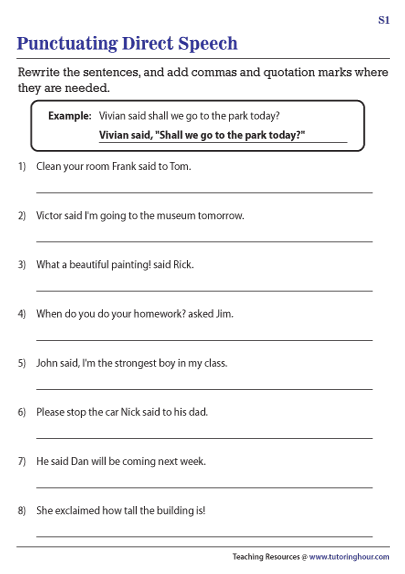
Related Printable Worksheets
▶ Conjunctions and Commas
▶ Commas in a Series
Tutoringhour
What we offer, information.
- Membership Benefits
- How to Use Online Worksheets
- How to Use Printable Worksheets
- Printing Help
- Testimonial
- Privacy Policy
- Refund Policy
Copyright © 2024 - Tutoringhour
You must be a member to unlock this feature!
Sign up now for only $29.95/year — that's just 8 cents a day!
Printable Worksheets
- 20,000+ Worksheets Across All Subjects
- Access to Answer Key
- Add Worksheets to "My Collections"
- Create Custom Workbooks
Digitally Fillable Worksheets
- 1100+ Math and ELA Worksheets
- Preview and Assign Worksheets
- Create Groups and Add Children
- Track Progress

Reading & Math for K-5
- Kindergarten
- Learning numbers
- Comparing numbers
- Place Value
- Roman numerals
- Subtraction
- Multiplication
- Order of operations
- Drills & practice
- Measurement
- Factoring & prime factors
- Proportions
- Shape & geometry
- Data & graphing
- Word problems
- Children's stories
- Leveled stories
- Sight words
- Sentences & passages
- Context clues
- Cause & effect
- Compare & contrast
- Fact vs. fiction
- Fact vs. opinion
- Main idea & details
- Story elements
- Conclusions & inferences
- Sounds & phonics
- Words & vocabulary
- Reading comprehension
- Early writing
- Numbers & counting
- Simple math
- Social skills
- Other activities
- Dolch sight words
- Fry sight words
- Multiple meaning words
- Prefixes & suffixes
- Vocabulary cards
- Other parts of speech
- Punctuation
- Capitalization
- Narrative writing
- Opinion writing
- Informative writing
- Cursive alphabet
- Cursive letters
- Cursive letter joins
- Cursive words
- Cursive sentences
- Cursive passages
- Grammar & Writing
Breadcrumbs
- Quotation marks

Download & Print Only $6.89
Quotation marks worksheets
Punctuating speech: the quotation mark.
In these worksheets students punctuate speech , adding quotation marks and other punctuation as needed.

These worksheets are available to members only.
Join K5 to save time, skip ads and access more content. Learn More
More punctuation worksheets
Explore all of our punctuation worksheets , from ending punctuation to commas, apostrophes, contractions and punctuating letters and stories.
What is K5?
K5 Learning offers free worksheets , flashcards and inexpensive workbooks for kids in kindergarten to grade 5. Become a member to access additional content and skip ads.
Our members helped us give away millions of worksheets last year.
We provide free educational materials to parents and teachers in over 100 countries. If you can, please consider purchasing a membership ($24/year) to support our efforts.
Members skip ads and access exclusive features.
Learn about member benefits
This content is available to members only.
- Grade Levels
- Search Site
Quotation Marks Worksheets
Related ela standard: l.4.3.
Quotation marks are primarily used to indicate that the text that appears within them is direct speech. The use of a comma and quotations often confuse students. We suggest you read the sentence aloud to yourself before making any decisions. If the quoted text flows with your sentence, no comma is needed. If the flow is broken by the quotes, pop in a comma. Students often suffer from a level of confusion when they see quotes used to indicate the title of things. This sizable collection of worksheets will help students become comfortable the use of quotation marks.
Quotation Marks Worksheets To Print:
Be the Grader - Read each sentence. If it is punctuated correctly, circle the check mark. If they are not used correctly, circle the X.
Mr. Dylan Takes a Dip! - Choose the sentence from each set that is punctuated correctly. This one has a large number of quotes and commas to work.
Use Your Words - Underline each speaker's words. Then rewrite the passage, adding quotation marks where necessary.
Direct Speech and Quotation Marks - Determine whether each sentence below contains direct or indirect speech. Write direct or indirect on the line.
Kim and Kevin at the Playground - Rewrite the dialogue in the speech bubbles below. Add commas and a series of quotes where they are needed.
Directed! - Read the story below. Underline direct speech. Then use a colored marker or colored pencil to add quotation marks and commas where needed.
Quote Me On This - Quotes are used around the titles of songs, poems, short stories, newspaper articles, and when referencing chapters in books.
In the Meadow - Rewrite the dialogue from the cartoon, using direct speech. Punctuate correctly.
Punch-uate-It - Rewrite the indirect speech as direct speech. Punctuate correctly. It will require you to say them aloud, at times.
Can I Quote You On That? - You use punctuation to indicate that you are quoting exactly what someone said.
Missing Marks - Add punctuation marks where needed in each sentence below. If the sentence is already punctuated correctly, place a check mark next to the sentence.
Correcting Sentences That Contain Direct Speech - Use commas, quotation marks, capital letters, or make any other changes necessary in order to rewrite the sentences correctly.
Big John and Little Joe - Copy each quote on the lines below. Be careful to add commas and quotation marks where they are needed.
Punctuation and Direct Speech - Read each sentence. If it is punctuated correctly, circle the smiley face. If they are not used correctly, circle the X.
Pencily Practice - Rewrite each sentence so that it uses direct speech. You will have to do a good bit of rewording here.
What is the Purpose of Quotation Marks?
Punctuation plays an important role in the English language. It has so many uses in the sentence structure. Quotation marks are significant elements of punctuation. They have many different purposes to fulfill that are mentioned below.

For Dialogues
Quotation marks play a significant role in many fiction writings. This is because the dialogues of fiction writing are incomplete without the use of quotes to indicate that speech is being transferred. It is extremely important to add quotes when you are writing a line for a character in a fiction story. All plays, dramas, and fiction stories use quotation marks for dialogues. They are used at the beginning and ending of the sentence.
For Parts of Composition
Quotation marks are also used in sentences where you are using the names of titles, books, movies, songs, etc. This is to differentiate them from the rest of the text. Names of books, poems, stories, movies and songs are always enclosed in quotes in sentences.
For Phrase in a Phrase
Another important usage of this form of punctuation is for a phrase in a phrase. The self-referential words are always used encapsulated in quotation marks. For example, "moon and month are related", and "reared its ugly head".
One of the most popular uses of quotation marks is for the quotes. Whenever you want to mention the work or sayings of someone else in your writing, you use quotation marks to enclose that text. This helps in letting the readers know that this is the quotation of someone else. They are used to signal that these are famous words of someone else.
For Epithet
Another purpose for using this form of punctuation is to enclose epithet in a sentence. They help in making a characteristic or trait more dominant in the sentence. Always use quotation marks for epithets.
Teachers: Upgrade Now
- Print all 25,000+ worksheets
- All grade levels and topics
- Save endless hours of your time...
- Answers to everything too!
Get FREE English Worksheets In Your Email
- How We Are Aligned To The Common Core
- Educator Resources
- Privacy Policy
- Newsletters
© English Worksheets Land . All rights reserved.

- Active & Passive Voice
- Cause & Effect
- Compound Words
- Contractions
- Direct & Indirect Speech
- Capital Letters
- Punctuation Mix
- Sentence Endings
- Speech Marks
- Figurative Language
- Homophones & Homographs
- Parts of Speech
- Persuasive Language
- Possessive Nouns
- Sentence Types & Structures
- Synonyms & Antonyms
- Sight Words
- Phonics, Sounds & Letters

- - Active & Passive Voice
- - Cause & Effect
- - Compound Words
- - Contractions
- - Direct & Indirect Speech
- › Capital Letters
- › Commas
- › Punctuation Mix
- › Sentence Endings
- - Figurative Language
- - Homophones & Homographs
- - Parts of Speech
- - Persuasive Language
- - Possessive Nouns
- - Sentence Types & Structures
- - Synonyms & Antonyms
- Early Years
- Middle Primary
- Upper Primary
- Most popular
English / Grammar & Language / Editing & Punctuation / Speech Marks
Browse our collection of speech marks worksheets and resources. Speech marks, often called quotation marks, are used to signal direct speech. These resources help teach how to identify and correctly punctuate direct speech in writing.
Use the filter above to narrow the results by resource type and/or grade level.

Editing Reference Card
A reference card to support students in the editing process of their writing. CUPS: Capitals, Understanding, Punctuation, Spelling.
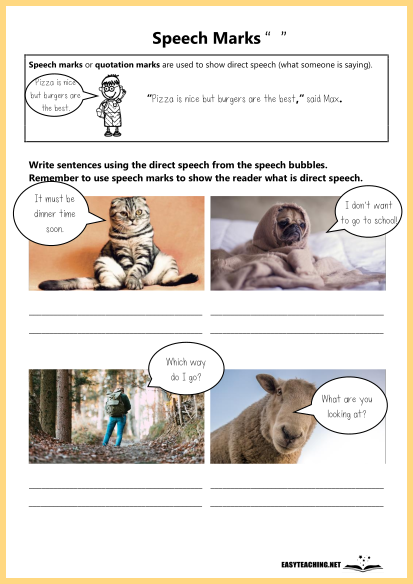
Speech Bubble to Direct Speech (2)
Write (and punctuate) a sentence containing direct speech to match each of the given pictures.
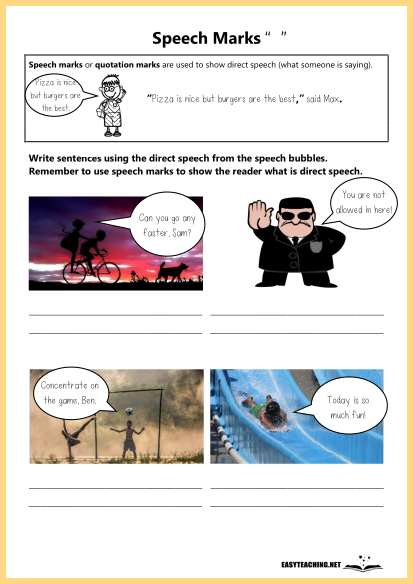
Speech Bubble to Direct Speech (1)
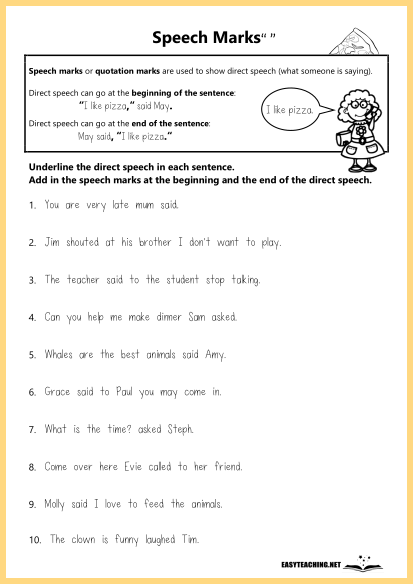
Missing Speech Marks (Easier)
Add in the speech marks in the correct places. Use the guide to help add in capital letters and commas where they are needed.
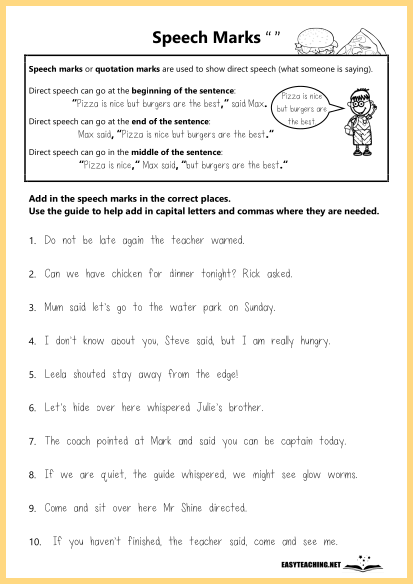
Missing Speech Marks
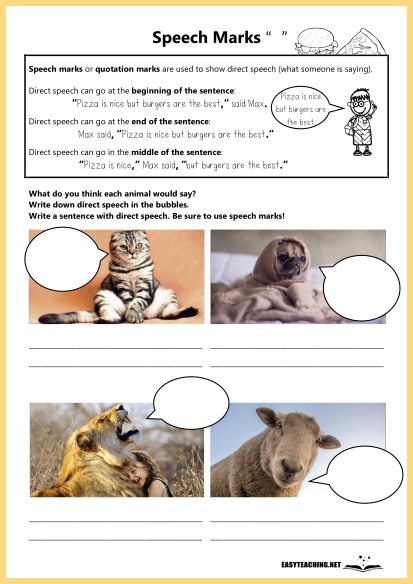
Writing Direct Speech (2)
Fill in the speech bubble to match each picture and then write a sentence containing direct speech to match.
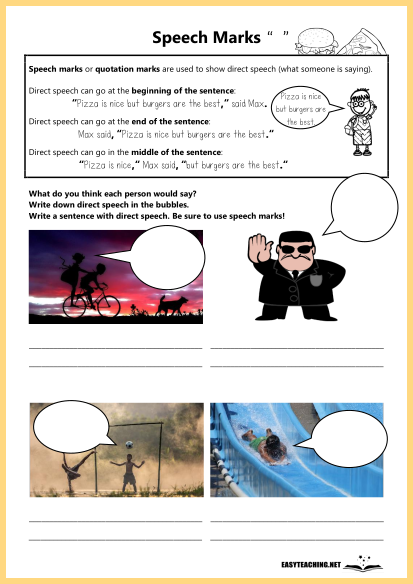
Writing Direct Speech (1)
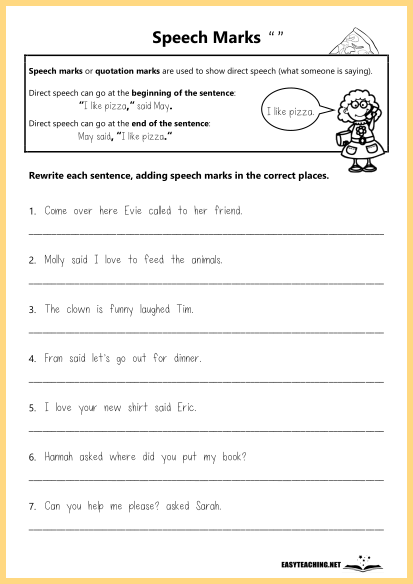
Missing Speech Marks: Rewrite (2)
Rewrite each sentence using speech marks to punctuate the direct speech. Add in capital letters and commas where they are needed.
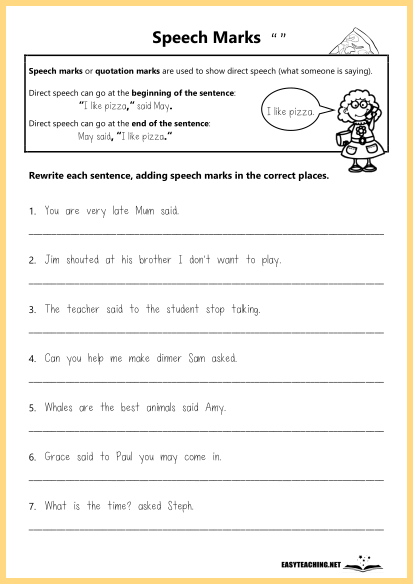
Missing Speech Marks: Rewrite (1)

Edit for Speech Marks (2)
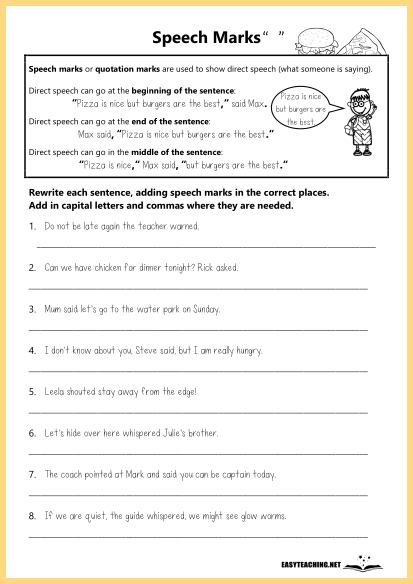
Edit for Speech Marks (1)
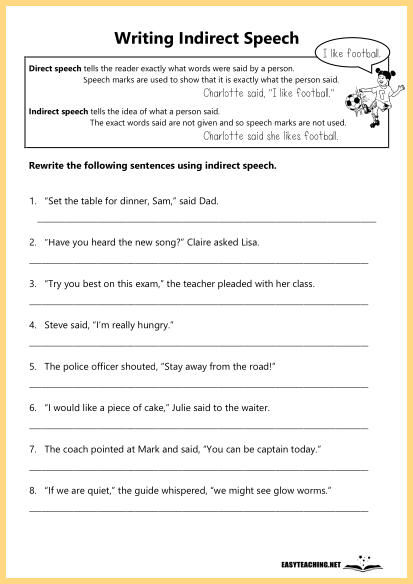
Change Direct Speech to Indirect
This worksheet helps students learn to write in indirect speech. Change the sentence containing direct speech to indirect speech.

IMAGES
VIDEO
COMMENTS
Direct speech contains words that are actually uttered by the speaker and are enclosed in inverted commas known as quotation marks, quotes or speech marks. Working through these printable worksheets on quotation marks in direct speech, you need to place a comma after the introductory reporting clause.
K5 Learning offers free worksheets, flashcards and inexpensive workbooks for kids in kindergarten to grade 5. Become a member to access additional content and skip ads. Quotation marks worksheets. In these worksheets students punctuate speech, adding quotation marks and other punctuation as needed. Free punctuation worksheets from K5 Learning.
Quotation marks are a form of punctuation that serve the purpose of transferring information to our readers. We use them to convey that words that write came from a specific source word for word. They can be used to indicate the title of a work. They can even be used to imply an alternate meaning. The worksheets that you will find here present ...
Direct Speech and Quotation Marks - Determine whether each sentence below contains direct or indirect speech. Write direct or indirect on the line. Kim and Kevin at the Playground - Rewrite the dialogue in the speech bubbles below. Add commas and a series of quotes where they are needed. Directed! - Read the story below. Underline direct speech.
Marks.PDF. Direct Speech - Speech. Speech marks inverted (or ) show commas when someone You will see them “speech written ” or ‘sp ’. ech in books. Task One. Copy these sentences into your correct Rememb places. r: The speech marks said. Copy all the other punctuation. 1. Hello, said the man. 2.
Browse our collection of speech marks worksheets and resources. Speech marks, often called quotation marks, are used to signal direct speech. These resources help teach how to identify and correctly punctuate direct speech in writing. Use the filter above to narrow the results by resource type and/or grade level.
Quotation marks are used in a written sentence to show a direct quote from somebody. Example: David walked into the room and said, "I can't wait to eat cake!". They can also be used to show that a word is being spoken about rather than used in a sentence. Example: The word "spoken" has six letters in it. Practice embedding quotation marks ...
Rule: Commas and periods typically go inside the quotation marks in American English. Example: The article was titled “Breaking News,” and it caught my attention. Direct Quotes: Rule: Use quotation marks around the exact words spoken by someone. Example: She said, “I’ll be there by 5:00 PM.”.
This comprehensive Quotation Marks & Commas in Direct Speech resource is excellent for teaching and assessing students' understanding of using commas and quotations to mark direct speech and quotations from the text. Your students will also understand the difference between direct speech and ind...
Explanatin of and activity using direct speech and placement of quotation marks. Welcome to ESL Printables , the website where English Language teachers exchange resources: worksheets, lesson plans, activities, etc.